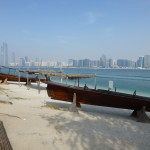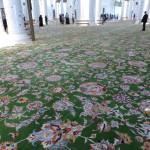
We drove about 40 minutes from Abu Dhabi’s airport to its shoreline, that stretch along the Persian Gulf of pedestrian walkway and motorway for expensive cars known as the Corniche. But we saw no sand.

We walked the streets within the city and found plenty of concrete sidewalks, black-topped roads, neck-craning high and human-scale low buildings amid lots of horticulture. Still, we saw barely a few grains of sand.

We were in the capital of the UAE, its governmental center. Yet, where was the famous desert of the Arabian peninsula, the plentiful sands of the emirates?
We drove the immaculate lanes of the Corniche, from the islands north of the city to the highly touted, pyramidal Emirates Palace Hotel at the road’s southern end, a place whose gilt trim would do Trump proud.

Inside the hotel a visitor can savor the hushed air of privilege along impossibly broad hallways and atriums. One can enjoy a museum’s worth of Phoenician, Egyptian, Greek, Roman, Mexican relics that somehow found their way here to be sold at thousands of dollars (40000 dirhams and up). The hotel’s most impressive feature was the stunning backdrop of a half dozen new skyscrapers visible from the main entrance. Yet, no sand allowed, even at the pool.

Jutting out in the water beyond the Emirates Palace, midway between the hotel and the city’s Heritage Village, billowed the sail-topped Marina Mall, an expansive white structure so much larger than the actual marina. The Village itself is an unimaginative recreation of a presumably authentic local fishing village.

In reality, it’s a set of craft and souvenir shops urging money from the busloads of Europeans looking for something with which to remember Abu Dhabi. But we did find a narrow strip of cultivated white sand that almost seemed hand-made as part of the village display.

Walking the Corniche, we saw plenty of green landscaping. We did spy some sand on a spit across the bay where powered and sail boats, jet skis and yachts bumped along waves whipped up by winds. Further along we reached the dazzling-white powdery sands of the Corniche Beach. That too was not at all like the tourist photos of the real desert, those red standing waves of windblown dunes.

Instead, this was a California-style beach, cultivated and managed. Part of the beach was quite wide, perhaps about 150 meters. Workers raked the beach clean of wisps of thin seaweed. As we kept going, we reached a more exclusive section, with beach chairs and cabanas for hire. That piece ended in a narrow section of equally manicured sand where hundreds of locals clustered in the evening, elbowing tourists at food services like Lebanese cuisine as well as western favorites like Cinnabon and Cold Stone Creamery.

Clearly we found lots of water in the desert. Our of the Persian Gulf, Abu Dhabi extracts a good deal of fresh water via desalination plants. Along its Corniche, we passed an extensive garden with its own good-sized lake.

In the Norman Foster reimagining of the old markets or souks of the desert, a low lying and inviting wood-latticework structure, we found a water feature at the bottom of the elevator into the parking lot.
We even found rain in the desert. For an hour or so, we could feel some intermittent drips. Later, we saw that the streets were somewhat damp. A few puddles survived till the dawn.

And we found both water and greenery in abundance on our visit to the Zayed Mosque, a grand white prayer to Allah erupting out of a confluence of waterways, bridges and roadways connecting key portions of Abu Dhabi. Rippling pools, as well as the requisite foot bathing area, surround the main building. Orderly manicured and well-watered gardens invited quietude and meditation.

Predominant, however, were the megatons of marble (from Macedonia) that comprise most of the building and courtyards. Everything is giant, reminiscent to us of the huge mosques the Islamic Mughals built in India. The enormous courtyard, the stolid walls and the 82 domes planted atop are all blindingly white when the sun is high up, but toward sunrise and sunset the varying tints of the marble start to appear.

Often in-laid in the marble (and in the huge carpet of the prayer hall) sprout imaginary flowers and vines of colored stone, bringing art nouveau aesthetics to mind. Yet again, no sand at all to be found on our way here or at the mosque.

We figured we might never find any real desert.
Up high, on one of the many rooftops of older buildings that consistently top out around 20 stories, we did finally locate some real stretches of sand surrounding the commercial harbor, near Port Zayed (the same ruler for whom the mosque and, it seems, most of the city is named). And there seemed to be more far off outside the city.
Surely, we thought, while on the hour’s drive north to Dubai, we’ll spy some of that native desert, those wind-whipped dunes the tourist brochures show. Not quite. There was some sand – on the islands just north of Abu Dhabi and along some short stretches of the highway before the expanding city of Dubai took over. But most of it was flattened out, seemingly prepared for more development. Some of it had clearly been planted with regular rows of trees or bushes. In general, it was cordoned off by fencing as if it were precious and somehow unapproachable, or perhaps just to keep the stuff from violating the cleanliness and smoothness of the high-speed roadway.
The sand may be here if you look hard enough or far out enough. But, to accommodate the growing city, it seems kept rather carefully in its proper place.
(Footnote: Oddly for a place where it proved hard to find the sands of the desert, a vicious sandstorm struck here a few days after we left. That whipped up tiny particulates of the stuff across the city, from somewhere out there, browning out the sky.)
(Also, for more pictures from UAE and Oman, CLICK HERE to view the slideshow at the end of the UAE-Oman itinerary page.)






Great description, I didn’t think about the sand when I was there